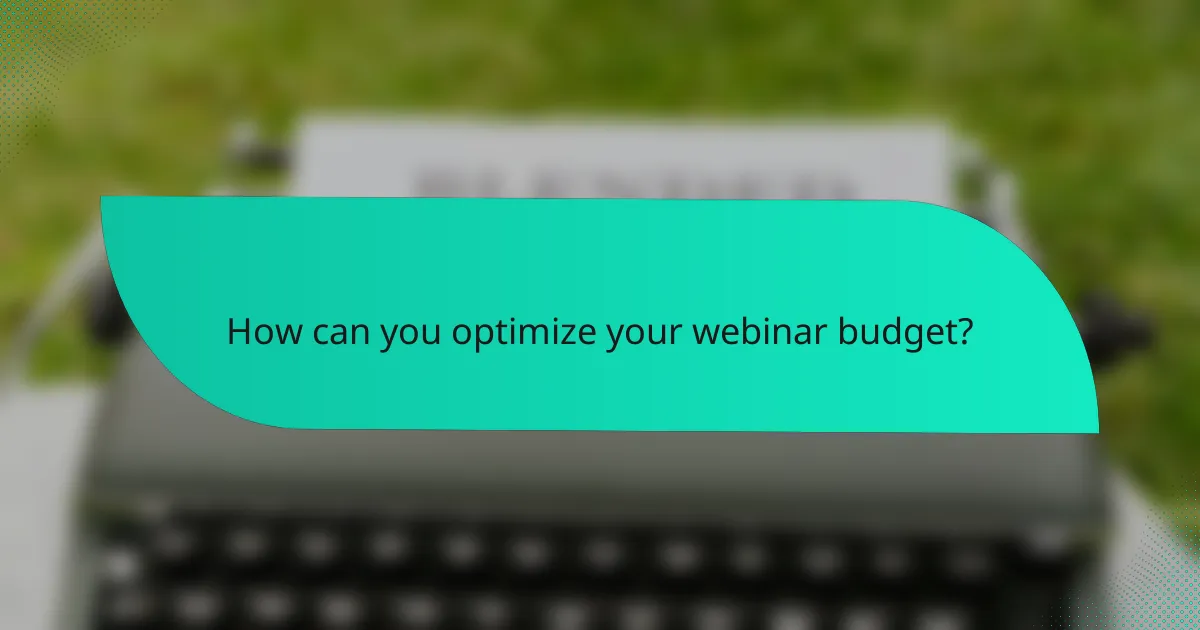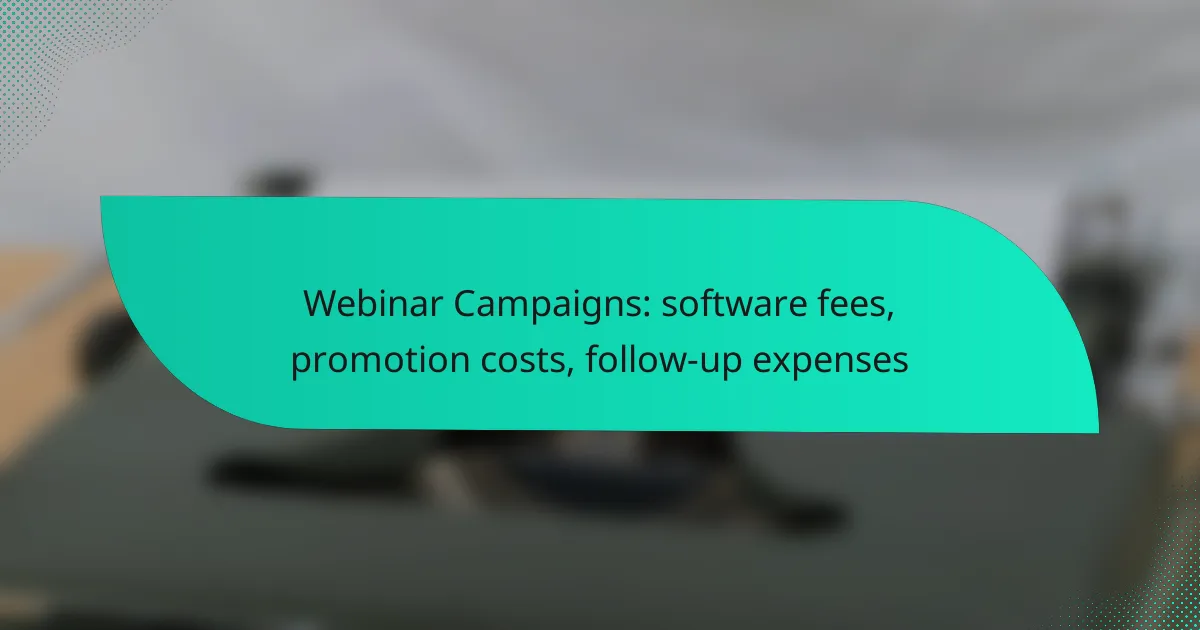When planning a successful webinar campaign, it’s essential to consider various costs, including software fees, promotion expenses, and follow-up activities. Webinar software in the UK can range from £10 to £100 per month, depending on features and participant limits. Additionally, promoting your webinar may require a budget of several hundred to thousands of dollars, while follow-up costs will vary based on your engagement strategies and tools used.

What are the costs of webinar software in the UK?
The costs of webinar software in the UK can vary significantly based on features, subscription plans, and the number of participants. Generally, users can expect to pay anywhere from £10 to £100 per month, depending on the platform and the level of service required.
Popular platforms like Zoom and GoToWebinar
Zoom and GoToWebinar are among the most widely used platforms for hosting webinars in the UK. Zoom offers a basic plan that starts around £11.99 per month, while GoToWebinar typically starts at about £39 per month. Both platforms provide essential features like screen sharing, recording, and participant engagement tools.
When choosing a platform, consider the specific needs of your audience and the types of webinars you plan to host. For example, if you require advanced analytics or larger participant limits, you may need to opt for higher-tier plans.
Monthly vs annual subscription fees
Many webinar software providers offer both monthly and annual subscription options. Opting for an annual plan often results in cost savings, typically around 15-20% compared to paying monthly. For instance, if a monthly plan costs £30, the annual plan might be available for around £300.
When deciding between monthly and annual subscriptions, evaluate your usage frequency. If you plan to host multiple webinars throughout the year, an annual subscription may be more economical.
Free vs paid features comparison
Most webinar platforms provide a free tier with limited features, which can be suitable for small events or testing purposes. Free versions often restrict the number of participants, duration, or available tools, such as analytics and branding options.
Paid features typically include enhanced participant limits, advanced reporting, and customization options. For example, while a free plan might allow only 100 participants, a paid plan could accommodate up to 1,000. Assess your requirements carefully to determine if the investment in a paid plan is justified for your webinar goals.

How much should you budget for promoting a webinar?
Budgeting for promoting a webinar typically involves allocating funds for various channels, including social media, email marketing, and potential partnerships. A well-rounded budget can range from a few hundred to several thousand dollars, depending on your goals and audience reach.
Social media advertising costs
Social media advertising is a powerful way to reach a targeted audience for your webinar. Costs can vary significantly based on the platform, with Facebook and Instagram ads generally ranging from $0.50 to $3.00 per click, while LinkedIn may charge $5.00 to $10.00 per click due to its professional focus.
Consider setting a daily budget that aligns with your overall marketing strategy. A common approach is to allocate around 20-30% of your total promotional budget to social media ads, ensuring you can test different ad creatives and targeting options for optimal results.
Email marketing expenses
Email marketing can be a cost-effective way to promote your webinar, especially if you already have a mailing list. Costs typically include subscription fees for email marketing platforms, which can range from $10 to $300 per month based on the number of subscribers and features required.
In addition to platform fees, consider the costs of creating engaging email content. Investing in professional design or copywriting can enhance your emails’ effectiveness, potentially increasing registration rates. Aim for a budget that allows for at least three to five promotional emails leading up to the event.
Influencer partnerships and sponsorships
Partnering with influencers or securing sponsorships can amplify your webinar’s visibility. Costs for influencer partnerships can vary widely, from a few hundred to several thousand dollars, depending on the influencer’s reach and engagement levels.
When considering sponsorships, evaluate the potential return on investment. A well-chosen influencer can provide access to a relevant audience, but ensure that their values align with your brand. Allocate a portion of your budget—around 10-20%—for these partnerships to maximize your promotional efforts.

What are the follow-up expenses after a webinar?
Follow-up expenses after a webinar include costs associated with engaging attendees, gathering feedback, and repurposing content. These expenses can vary based on the tools and strategies you choose to implement.
Post-webinar email campaigns
Post-webinar email campaigns are essential for maintaining engagement with attendees and nurturing leads. Costs can include email marketing software fees, which typically range from $20 to several hundred dollars per month depending on the size of your list and features needed.
When planning your email strategy, consider segmenting your audience to tailor messages effectively. A/B testing subject lines and content can improve open and click-through rates, maximizing your investment.
Survey and feedback tool costs
Collecting feedback through surveys is crucial for understanding attendee experiences and improving future webinars. Many survey tools offer free basic plans, while more advanced features can cost between $15 and $100 per month.
Choose a tool that integrates well with your existing systems to streamline data collection. Keep surveys concise to encourage higher response rates, focusing on key aspects such as content relevance and presentation quality.
Content repurposing expenses
Repurposing webinar content can extend its value and reach, but it may involve additional costs. This can include hiring freelancers for editing or graphic design, which might range from $50 to $500 depending on the complexity of the project.
Consider creating blog posts, infographics, or video snippets from your webinar. This not only enhances your content library but also helps in attracting new audiences through various channels.

What factors influence webinar campaign costs?
Webinar campaign costs are primarily influenced by audience size, engagement levels, format, and duration. Understanding these factors helps in budgeting effectively and maximizing the return on investment.
Audience size and engagement level
The size of your audience directly impacts costs, as larger groups may require more robust technology and support. For instance, platforms often charge based on the number of attendees, with fees ranging from a few dollars to several hundred, depending on the capacity.
Engagement level also plays a crucial role. Highly engaged audiences may lead to higher conversion rates, justifying additional expenses for interactive features like polls or Q&A sessions. Consider investing in tools that enhance participation, as they can significantly improve outcomes.
Webinar format and duration
The format of your webinar—whether it’s a live event, pre-recorded session, or hybrid—affects both production and promotional costs. Live webinars typically incur higher costs due to the need for real-time interaction and technical support.
Duration is another key factor; webinars lasting over an hour may require additional resources for promotion and follow-up. Generally, aim for a duration of 30 to 60 minutes to maintain audience interest while balancing costs. Evaluate the trade-offs between longer sessions for in-depth content versus shorter, more focused presentations.

How can you optimize your webinar budget?
To optimize your webinar budget, focus on minimizing costs while maximizing reach and engagement. This involves strategically selecting software, leveraging free promotional channels, and effectively measuring your return on investment.
Leveraging free marketing channels
Utilizing free marketing channels can significantly reduce your webinar promotion costs. Consider using social media platforms, email newsletters, and community forums to spread the word about your event without incurring additional expenses.
Engage with your audience by creating shareable content related to your webinar topic. Encourage participants to share the event with their networks, which can amplify your reach at no cost.
Using analytics to measure ROI
Measuring the return on investment (ROI) of your webinar is crucial for budget optimization. Use analytics tools to track registration numbers, attendance rates, and engagement metrics to assess the effectiveness of your promotional efforts.
Set clear goals for your webinar, such as lead generation or brand awareness, and compare the outcomes against your costs. This will help you identify which strategies yield the best results and where to allocate your budget in future campaigns.

What are the emerging trends in webinar campaigns?
Emerging trends in webinar campaigns focus on enhanced engagement, personalized content, and the integration of advanced technologies. These trends aim to improve attendee experience and increase conversion rates through interactive features and targeted marketing strategies.
Software fees
Software fees for webinar platforms can vary significantly based on features and audience size. Basic plans may start at around $15 to $50 per month, while advanced options with more capabilities can range from $100 to several hundred dollars monthly.
When selecting a platform, consider features such as attendee limits, recording options, and analytics tools. Popular platforms include Zoom, GoToWebinar, and Webex, each offering different pricing tiers and functionalities.
Promotion costs
Promotion costs for webinars can encompass various marketing strategies, including social media ads, email campaigns, and partnerships. Budgeting for promotion typically ranges from a few hundred to a few thousand dollars, depending on the scale of your campaign.
Utilizing targeted ads on platforms like Facebook and LinkedIn can yield better results. Consider allocating around 20-30% of your total webinar budget to promotion to maximize reach and engagement.
Follow-up expenses
Follow-up expenses often include costs associated with post-webinar surveys, thank-you emails, and additional content sharing. These costs can be minimal if using automated email tools, typically ranging from $10 to $50 per month for basic services.
Investing in a customer relationship management (CRM) system can enhance follow-up efforts by tracking engagement and nurturing leads. Ensure to allocate resources for personalized follow-ups, as they can significantly improve conversion rates.
